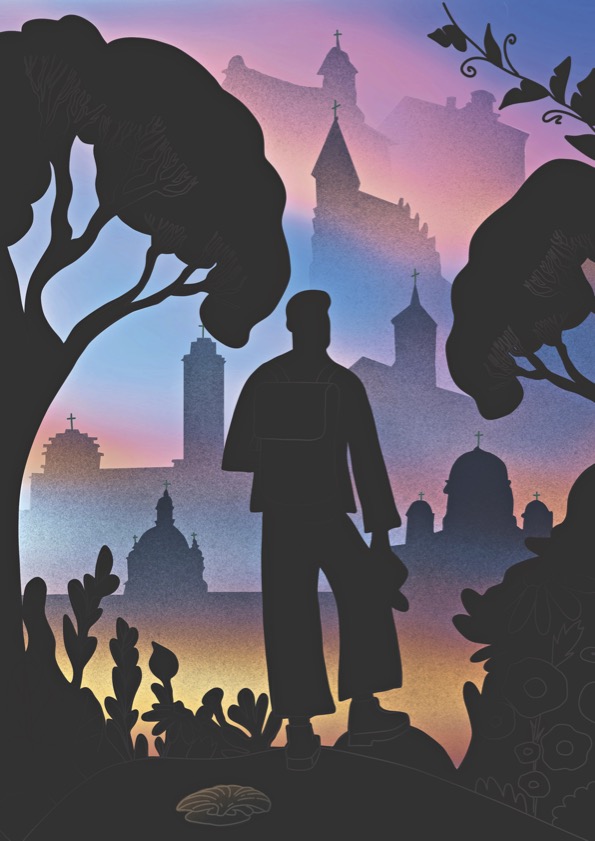“Walking helps you find your rhythm. You discover the rhythm of your heart, the rhythm of your feet, the rhythm of prayer, and your mind clears, allowing your thoughts to escape. Walking is truly very healthy for us. It also nourishes the spirit,” says Mantas Kuraitis, head of the John Paul II Pilgrim Center in Kaunas, who has been a member of the pilgrims’ community since 2015. Although when he visited Taizé in France – a place especially loved by pilgrims – he was surprised and wondered what they were doing there and why they found it so interesting. Now Mantas is actively involved in pilgrim activities and creates routes accessible to all Kaunas residents.
Pilgrims – religious travelers – are often associated with ancient times or the Middle Ages. What does modern pilgrimage look like?
Pilgrimage actually began in the early centuries when the apostles started traveling, and it gained even more popularity during the Middle Ages. Modern pilgrimage primarily involves modern methods of travel. A pilgrim today is still a traveler, often with religious intentions, but a modern pilgrimage, I think, differs mainly in that we can now travel more comfortably, using everything that helps us reach our destination faster: planes, buses, cars, as well as walking scooters, and bicycles. It also differs because of accessible technology: navigation, pre-planned routes, and interactivity.
What constitutes a pilgrimage? How is it different from a hike or a trip?
Pilgrimage differs from other types of traveling in that you don’t just see the sights or take pictures: you’re not just a tourist. A pilgrim feels and goes through inner, spiritual experiences.
I often tell pilgrims that the essence of pilgrimage involves four stages. Some people think that pilgrimage means simply traveling to the Holy Land or some other sacred place. Others say that pilgrimage, like the Camino de Santiago, is simply the act of walking. For me, it was beautiful to realize that there are four stages, and they are all equally important.
The first stage is preparation. This Pilgrim Center used to be unofficially called the ‘Pilgrimage Preparation Center’. People who work in such places say they can sense which pilgrims come prepared. Some return from a pilgrimage saying, “It was fun, and enjoyable,” while others return saying, “It changed my life.” The experience of a pilgrimage can be shaped by how well one prepares for the journey, which is why preparation is especially important.
The second stage is the journey itself. This can be walking, flying, taking a bus, or riding a bicycle. This leads us to the third stage of pilgrimage: the destination. Whether it’s the tomb of Christ, St. James, or any other pilgrimage site: Šiluva, the Gate of Dawn, the Hill of Crosses, etc.
The fourth stage, which I think is very important, is what the pilgrims do after the journey. This reflects what I will change in my life. If I don’t change anything in my life after the pilgrimage, something is wrong. It is these four stages that separate a pilgrimage from an ordinary journey.
Now we often see people going on pilgrimages for cultural or tourist purposes. What do you think of it?
There was definitely a time when it bothered me a little. Thank God, we have a pilgrim community, and I am surrounded by many wise people who give me advice and answer certain questions. The former Archbishop of Kaunas Lionginas Virbalas, who is dear to me, and a true pilgrim, who has traveled extensively and written a book, once advised me, “Mantas, God can work in all sorts of ways. Don’t worry; people travel for nature, for tourism. I’m completely at peace with it. And you should be open to them too.”
Then I started to explore more, and it turns out that, for example, the Way of St. James is also a cultural one. The pilgrimage routes of John Paul II and St. James are included among the cultural routes in Lithuania. They are both cultural and tourist routes, but at the same time, they are also pilgrimage routes. Now, I believe that these two areas don’t necessarily contradict each other.
Of course, it’s a bit disappointing when the spiritual aspect of pilgrimage is sometimes forgotten. For example, friends of mine have told me that while walking the Way of St. James in Spain, it’s unlikely you’ll meet a religious pilgrim at the end. Some people walk for sport, others for tourism, and yet others want to prove to themselves that they can do it. This can be somewhat irritating for pilgrims.
But in reality, these goals do not contradict each other; I believe they even complement each other beautifully. I might even say that culture and pilgrimage cannot be separated.
The Pilgrim Center offers several pilgrimage routes around Kaunas and Lithuania. How did the idea of creating these routes come about?
Pilgrimages to Šiluva from our center have taken place before, but we developed this idea during the pandemic. Unable to travel abroad to traditional pilgrimage destinations, we had to adapt and find a way to continue our pilgrimage activities. This is how we came up with the idea of creating routes that can be traveled alone, with friends, family, or a large group.
Initially, we developed five routes that lead through picturesque locations where culture, tourism, and, of course, pilgrimage intersect. We marked them, created a map, and prepared them for pilgrims. The distances are short, up to 20 kilometers, which makes pilgrimage much more accessible. If you don’t have a month off to travel to Spain and walk several hundred kilometers on the Way of St. James, you can still experience pilgrimage with just one free day in Lithuania.

And how did you create the route Pilgrimage Treasure Hunt, which leads through the city of Kaunas?
I kept thinking: I’ve been working at the Pilgrim Center for so many years, and there still wasn’t a pilgrimage route in Kaunas, so we decided to create one together with the Kaunas Tourism Center. Kaunas has many religious sites. Mostly churches, but not only. We also have an Orthodox church, a synagogue, and a mosque. There are many other places as well. To make a pilgrimage in Kaunas more interesting, we created a game inviting participants to find treasures and collect eight stamps. And the first stop, of course, is the Pilgrim Center.
After collecting at least half of the stamps, you can receive a certificate from our center confirming that you are a Kaunas pilgrim. According to the Bible, treasure is where your heart is. So, the treasure found is not physical but rather what you experience by visiting these places. The search itself is the treasure. I definitely recommend all Kaunas residents to experience this largely undiscovered pilgrim Kaunas. The route can be covered in one, two or more days.
Who would you recommend pilgrimages to? Maybe there are times when you wouldn’t recommend them.
Anyone can go on pilgrimages: non-believers, devout believers; children can go on shorter hikes or go to camps and seniors can go to Šiluva with us by bus. Neither age nor a person’s religious beliefs should prevent them from going on pilgrimages. That’s what I love about pilgrimage: everyone is welcome.
If you could give three pieces of advice to someone planning a pilgrimage, what would they be?
The first piece of advice is to make sure to prepare and not skip the initial stage. The second is that pilgrimage, in my opinion, is inseparable from intention. Intention is a request or gratitude. A pilgrim needs to know the purpose of their journey.
For example, when our son was born, we traveled to the Holy Land, Nazareth, to thank the Virgin Mary. We traveled, volunteered, and stayed there for a month. This is one of the most beautiful of my trips. The journey is not necessarily penance for one’s sins, as some may imagine. Pilgrimages can be joyous and stemming from gratitude.
The third tip is to travel with an open heart. We very often imagine how things should be, work, and look like. We often have our own expectations, and our own plans, but God sees more, God knows more. It is important to be open so that God can act, rather than just you acting on your own during the journey.
piligrimyste.lt




